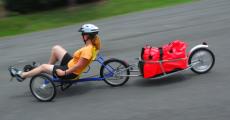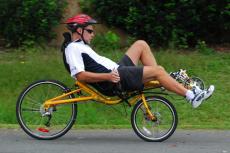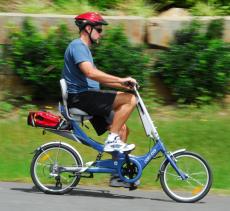Bikes, bikes…
 My wife’s business Speed Pedal sells recumbent trikes, folding bikes and bike trailers. Through her work, she often gets to meet people who collect unusual pedal-powered machines. So there’s the man with something like 100 bikes – everything from historic to current, from tandem to single to well… you name it! And another bloke who rides just weird looking machines. Complete with his long flowing beard, on the road he looks an amazing eccentric.
My wife’s business Speed Pedal sells recumbent trikes, folding bikes and bike trailers. Through her work, she often gets to meet people who collect unusual pedal-powered machines. So there’s the man with something like 100 bikes – everything from historic to current, from tandem to single to well… you name it! And another bloke who rides just weird looking machines. Complete with his long flowing beard, on the road he looks an amazing eccentric.
I always figured that was all a bit bizarre, but I now think I am heading in the same direction.
You see, I’ve recently bought two new bikes. And both of them are pretty strange. However, the difference that I have to a collector is that I am buying them only to use, and if I don’t like the machine, I’ll sell it.
To people reared on the traditional diamond framed bike, the fact that other bike designs even exist is a source of surprise. I have previously covered (both in this blog and AutoSpeed) the design and development of my favourite pedal-powered machine – a full suspension recumbent trike.
However, while I love the machine, it has a major disadvantage – it is large and unwieldy to send to distant places.
 On the other hand, the Brompton folding bikes that Georgina sells are quite astonishingly compact. The 16-inch wheels and very clever frame design allow these bikes to be folded in a box so small that when flying interstate, they can go as checked-in baggage and attract no extra cost at all. When as a family we travel within Australia, we can take the two Bromptons and a Burley child trailer and pay no extra. But, while I love the Bromptons, they have poor ride quality (despite the rear suspension) and so on longer rides I find them uncomfortable.
On the other hand, the Brompton folding bikes that Georgina sells are quite astonishingly compact. The 16-inch wheels and very clever frame design allow these bikes to be folded in a box so small that when flying interstate, they can go as checked-in baggage and attract no extra cost at all. When as a family we travel within Australia, we can take the two Bromptons and a Burley child trailer and pay no extra. But, while I love the Bromptons, they have poor ride quality (despite the rear suspension) and so on longer rides I find them uncomfortable.
Still, when there’s a choice of walking or the Brompton, I’ll take the Brompton any day!
My new-found interest in bikes (I didn’t ride a bike most of my adult life) has led me to looking in a minor way at the history of alternative biking. If you do this, you’ll find that there’s plenty of evidence to suggest that the fastest bike designs are not the diamond frame machine that you see racing, but recumbents. (Recumbents are banned from nearly all races.)
The lower aero profile and ability to push back against the seat support this idea – as does the fact that the outright speeds record for pedal-powered machines have all been achieved on recumbents.
So I thought it’d be pretty interesting to try a recumbent bike. Recumbent bikes come in two basic breeds – short wheelbase, where the rider is positioned over the wheels, and long wheelbase, where the rider is positioned between the wheels. However, like all these alternative machines, the prices are very high.
So I didn’t do anything about buying one until a short wheelbase recumbent appeared on eBay. Located close to me, the bike had a starting price of AUD$500 and I got it for AUD$660. An ActionBent (a Taiwanese brand imported into the US and thence to Australia), the bike is regarded as being at the low end of the scale in terms of expense and quality. But as a machine on which to discover recumbent bikes, it was ideal.
The ActionBent Focus uses a 26 inch rear wheel and a 20 inch front wheel. It has 27 derailleur gears and under-seat steering. The rear wheel is suspended using a combined air spring/shock.
 To get on, you step over the machine, put your bum down on the heavily reclined seat, place one foot on the pedals and push off, then putting the other foot on the pedals and steering to maintain balance.
To get on, you step over the machine, put your bum down on the heavily reclined seat, place one foot on the pedals and push off, then putting the other foot on the pedals and steering to maintain balance.
‘Balance’ and ‘steering’ are the two key words. Large steering inputs are needed to remain upright, and (at least for me!) much more road width is taken up than would be the case on a conventional bike. But I’ve never taken a tumble and got the hang of it fairly quickly.
So is it good? No, not really.
I don’t much like the seat (padded fibreglass which is hard and not the right shape), don’t like the steering feel and balance (even at speed, the bike never settles to be really stable), hate the ride quality (honestly, so many bike suspensions are awful it’s a wonder people don’t complain more loudly), and am surprised at how long and unwieldy this machine is (and long wheel base recumbents would obviously be worse).
I like the acceleration that’s achievable and – well, I reckon that’s all I like!
But what about speed? Yes, I think the bike can be very fast – say on a velodrome or something like that. But I wouldn’t like riding it fast on a road or cycle path – too hard to swerve around obstacles, too hard to get a clear vision, and too bad a ride quality.
So, having tried the experience, I think I’ll be selling this bike.
And then, not a day after buying the ActionBent, another weird bike came up for sale. This one was a ‘crank forward’ design – not a full recumbent but one where rather than pushing vertically down on the pedals, the pedal axis is placed forward in the frame. This allows a more comfortable, wider seat to be used.
 The bike up for sale was a Giant Revive. Giant is a well known manufacturer of traditional bikes and the Revive seems to have been one of their few ventures into alternative machines.
The bike up for sale was a Giant Revive. Giant is a well known manufacturer of traditional bikes and the Revive seems to have been one of their few ventures into alternative machines.
Billed as a universal commuter, it uses a bespoke frame design, 7 derailleur gears and 20 inch wheels. However, what really attracted my attention was its rear suspension – incredibly unusually on a bike, it uses a long trailing arm with a low motion ratio spring/damper. As I have explained elsewhere, this is the approach I took on my trike – it has advantages in terms of anti-squat, frame loads, and spring and damper linearity and travel.
So off I went to look at the Revive. The instant adjustability was impressive (seat height, seat fore-aft, handlebar height, handlebar fore-aft) and the pedalling position comfortable. In my test ride I was surprised at how poorly the rear suspension worked, but I knew that technically it could perform very well – perhaps just the spring/damper unit needed changing. And there wasn’t only one of these bikes for sale – if we wanted to, we could have two. Like the ActionBent, the Revives were in mint condition.
I mulled it over, wondering how such a pair of bikes would fit into our scheme of things – especially when travelling. Then we decided – Bromptons for no-cost interstate travel as airline check-in baggage; Giant Revives that could be freighted to a city for riding day trips; and recumbent air suspension trikes freighted in big boxes (complete with camping gear) for touring holidays.
We’ll see how all that works out – but what are the Revives like?
In short, pretty impressive. The standard rear suspension, when properly adjusted to have near-zero spring preload and soft damping, works very well. The huge seat is comfortable, and the bike steers and balances fine. The gearing is a bit tall to climb steep hills (no standing on the pedals is possible) and would be much too tall to pull a child trailer and climb hills. (A front cog swap to give lower gearing should be easy enough.) But the Revive is probably the most comfortable bike I have ever ridden.
Lots of people seem to see ‘speed’ as the determining criterion in bike selection. I don’t really understand that (if I want to go fast, I drive a car) so to me, ‘comfort’ is by far the most important pedal machine factor. If I am comfortable, I am able to ride further with greater enjoyment. To be blunt, if my testicles and penis are numb, my bum is sore and my wrists are aching – well, why the hell would you want that?
And it’s probably in comfort that these alternative machines really stand head and shoulders above the traditional bike. Nothing – absolutely nothing – that I have experienced beats my air suspended recumbent trike for riding comfort, but as a more easily shipped package, the Revive isn’t bad. And, when nothing else could possibly be taken, the Brompton is the one.
There’s certainly more to bikes than first meets the eye. A bike collector? – maybe…

 Julian Edgar, 50, has been writing about car modification and automotive technology for nearly 25 years. He has owned cars with two, three, four, five, six and eight cylinders; single turbo, twin turbo, supercharged, diesel and hybrid electric drivelines. He lists his transport interests as turbocharging, aerodynamics, suspension design and human-powered vehicles.
Julian Edgar, 50, has been writing about car modification and automotive technology for nearly 25 years. He has owned cars with two, three, four, five, six and eight cylinders; single turbo, twin turbo, supercharged, diesel and hybrid electric drivelines. He lists his transport interests as turbocharging, aerodynamics, suspension design and human-powered vehicles.

on March 27th, 2008 at 4:34 pm
As someone who now has 3 bikes (plus two wrecks for spares) I can sympathize. Compared to owning cars, it is extremely easy for a bike owner to just get another one. A mountain bike for off road, a lightweight racer for the motorways, a cheaper, older racer for commuting….
And in terms of racing bikes, I used to be impressed with the way the motorbike guys could buy the bike equivalent of a new Ferrari for $15 000. Well with pushbikes you can buy the equivalent of a F1 car for a fraction of that. (And like an F1 car, a full race ready single speed fixed gear velodrome cycle is absolutely unsuited for the road. Unlike a F1 car, this doesn’t stop some people.)
But I really do see the need for a bike to be fast.
When I look at my commute to work, knocking the time from 1 hour to 40 minutes (i.e. going from a fat tyres Cruiser to a lightweight racer) makes the difference between me riding to work, and me driving instead. Plus, the cruiser is just a lot more work to push along, I might be more comfortable, but I’ll turn up later, sweatier, and exhausted.
Secondly, a really cool racing machine is just as good to show off at the office lunch table as a new sportscar, for the price of new sportscar tyres.
on March 28th, 2008 at 11:40 pm
Unlike cars and motorcycles, it’s quite cheap and easy to own a collection of bikes for different purposes. I have three, for short-haul commuting, long-haul touring and for faster club riding. Space rather than cost constraints prevents me from owning more. Conversely, cost dictates that I own only one car for all purposes.
on August 31st, 2008 at 10:33 pm
Where can I purchase pedicabs in australia???
i want 4 aleast…
on January 8th, 2009 at 11:38 am
I never thought of a crank forward design of bike. It makes sense, and the whole nether region pain wouldn’t exist with a flat-ish seat and backrest. The only problem is that I live in a hilly area, so to avoid standing up the only real option is either shorter gearing and/or motor assist. I must look into it more…
Incedentally with the pedicabs, there used to be a pedicab buisiness in Cairns that has now closed down. I looked at buying one of these to make some extra cash, but the licensing stopped me. That was in 2007, and up till June 08 (when I left) they still hadn’t made it back on the road. They are probably still available, and shouldn’t be that hard to track down. Sorry, but I have lost the contact details.